
The standard circulating coinage of the United Kingdom, British Crown Dependencies and British Overseas Territories is denominated in pennies and pounds sterling, and ranges in value from one penny sterling to two pounds. Since decimalisation, on 15 February 1971, the pound has been divided into 100 pence. Before decimalisation, twelve pence made a shilling, and twenty shillings made a pound.

Sterling is the currency of the United Kingdom and nine of its associated territories. The pound is the main unit of sterling, and the word pound is also used to refer to the British currency generally, often qualified in international contexts as the British pound or the pound sterling.
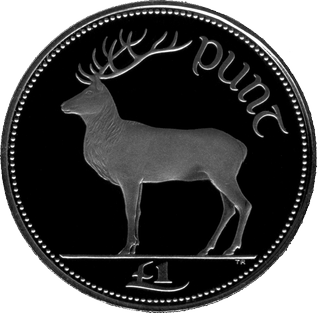
The pound was the currency of Ireland until 2002. Its ISO 4217 code was IEP, and the symbol was £ The Irish pound was replaced by the euro on 1 January 1999. Euro currency did not begin circulation until the beginning of 2002.

Decimal Day in the United Kingdom and in Ireland was Monday 15 February 1971, the day on which each country decimalised its respective £sd currency of pounds, shillings, and pence.
The pound is the currency of Guernsey. Since 1921, Guernsey has been in currency union with the United Kingdom and the Guernsey pound is not a separate currency but is a local issue of sterling banknotes and coins, in a similar way to the banknotes issued in Scotland, England and Northern Ireland. It can be exchanged at par with other sterling coinage and notes.
The pound, or Manx pound, is the currency of the Isle of Man, at parity with sterling. The Manx pound is divided into 100 pence. Notes and coins, denominated in pounds and pence, are issued by the Isle of Man Government.
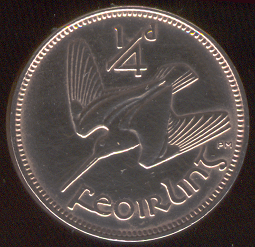
The farthing was the lowest value coin of the pre-decimal Irish pound, worth a quarter of a penny, 1⁄48 of a shilling or 1⁄960 of a pound. The coin had lost much of its value through inflation long before decimalisation in 1971, and during the 1960s no farthings were produced for general circulation; those minted in 1966 were produced for collectors' sets.

The halfpenny coin was the second smallest denomination of the pre-decimal Irish pound, worth 1⁄480 of a pound or 1⁄24 of a shilling. First issued in 1928 it ceased to be legal tender on 1 August 1969.

The threepence or 3d coin was a subdivision of the pre-decimal Irish pound, worth 1⁄80 of a pound or 1⁄4 of a shilling. Leath reul literally means "half reul", the reul being a sixpence coin worth about the same as the Spanish real. As with all other Irish coins, it resembled its British counterpart, as the Irish pound was pegged to the British pound until 1979.
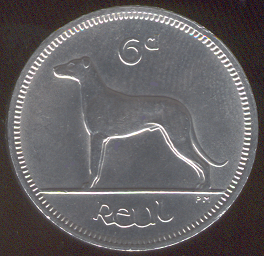
The sixpence coin was a subdivision of the pre-decimal Irish pound, worth 1⁄40 of a pound or 1⁄2 of a shilling. The Irish name réal is derived from the Spanish real; for most of the 19th century, a pound sterling was equal to five U.S. dollars, and a dollar was equal to eight reales, so that a real was equal to 1⁄40 of a pound. The variant spelling reul was used in the Coinage Act 1926, and appeared on the coins themselves even after a 1947 spelling reform established réal as the standard.
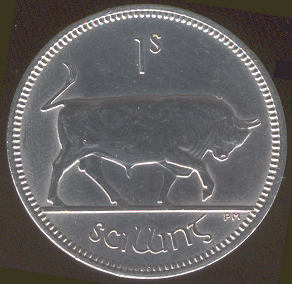
The shilling (1s) coin was a subdivision of the pre-decimal Irish pound, worth 1⁄20 of a pound. Worth 12d or half of a Florin.

The florin (2s) coin was a subdivision of the pre-decimal Irish pound, worth 1⁄10 of a pound. It was more commonly known as the two-shilling coin.
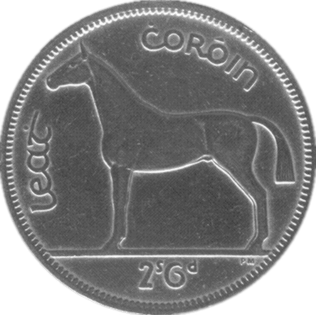
The half crown coin was a subdivision of the pre-decimal Irish pound, worth 1⁄8 of a pound. The half crown was commonly called "two and six" due to its value of two shillings and sixpence.
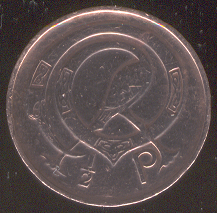
The decimal halfpenny coin was the smallest denomination of the Irish pound. It was first issued when the Irish currency was decimalised on Decimal Day, 15 February 1971. It was one of three new designs introduced all in bronze and featuring ornamental birds on the reverse. The coin value was weakened by inflation and very few were produced beyond the initial run for 1971. It was removed from circulation and demonetised on 1 January 1987.

The decimal one penny (1p) coin was the second-smallest denomination of the Irish pound. There were 100 pennies (pence) to the pound. The coin was first issued on Decimal Day, 15 February 1971. It was the second of three new designs introduced all in bronze, the others being a half-penny and a two pence coin. All featured ornamental birds designed by Irish artist Gabriel Hayes on the reverse.

The five pence (5p) coin was a subdivision of the Irish pound. It was introduced in Ireland on Decimal Day, 15 February 1971 and reused the design on the shilling coin produced for the Irish Free State in 1928. Some shilling coins remained in circulation until the early 1990s, with the same nominal value as the five pence coin.

The ten pence (10p) coin was a subdivision of the Irish pound. It was used in the Republic of Ireland from 1969 to 2002, with its last minting issue in 2000. It replaced the florin coin, of which it shared its design. Two different designs of the coin exist, both featuring a salmon on the reverse. The second was introduced in 1993 and is smaller, due to the reduction of the coin's value by inflation.
There have been three sets of coins in Ireland since independence. In all three, the coin showed a Celtic harp on the obverse. The pre-decimal coins of the Irish punt had realistic animals on the reverse; the decimal coins retained some of these but featured ornamental birds on the lower denominations; and the euro coins used the common design of the euro currencies. The pre-decimal and original decimal coins were of the same dimensions as the same denomination British coins, as the Irish punt was in currency union with the British pound sterling. British coins were widely accepted in Ireland, and conversely to a lesser extent. In 1979 Ireland joined the Exchange Rate Mechanism and the Irish punt left parity with sterling; coin designs introduced after this differed between the two countries.
Irish coins have been issued by a variety of local and national authorities, the ancient provincial Kings and High Kings of Ireland, the Kingdom of Ireland (1541–1801), the United Kingdom of Great Britain and Ireland (1801–1922), the Irish Free State (1922–1937), and the present Republic of Ireland. Since 2002, the Republic of Ireland has minted Euro coins, featuring symbols such as flax and the harp.

The one pound (£1) coin, worth one Irish pound, was used in Ireland from 20 June 1990 until the formal adoption of euro currency in 2002. The last issue was minted in 2000.















